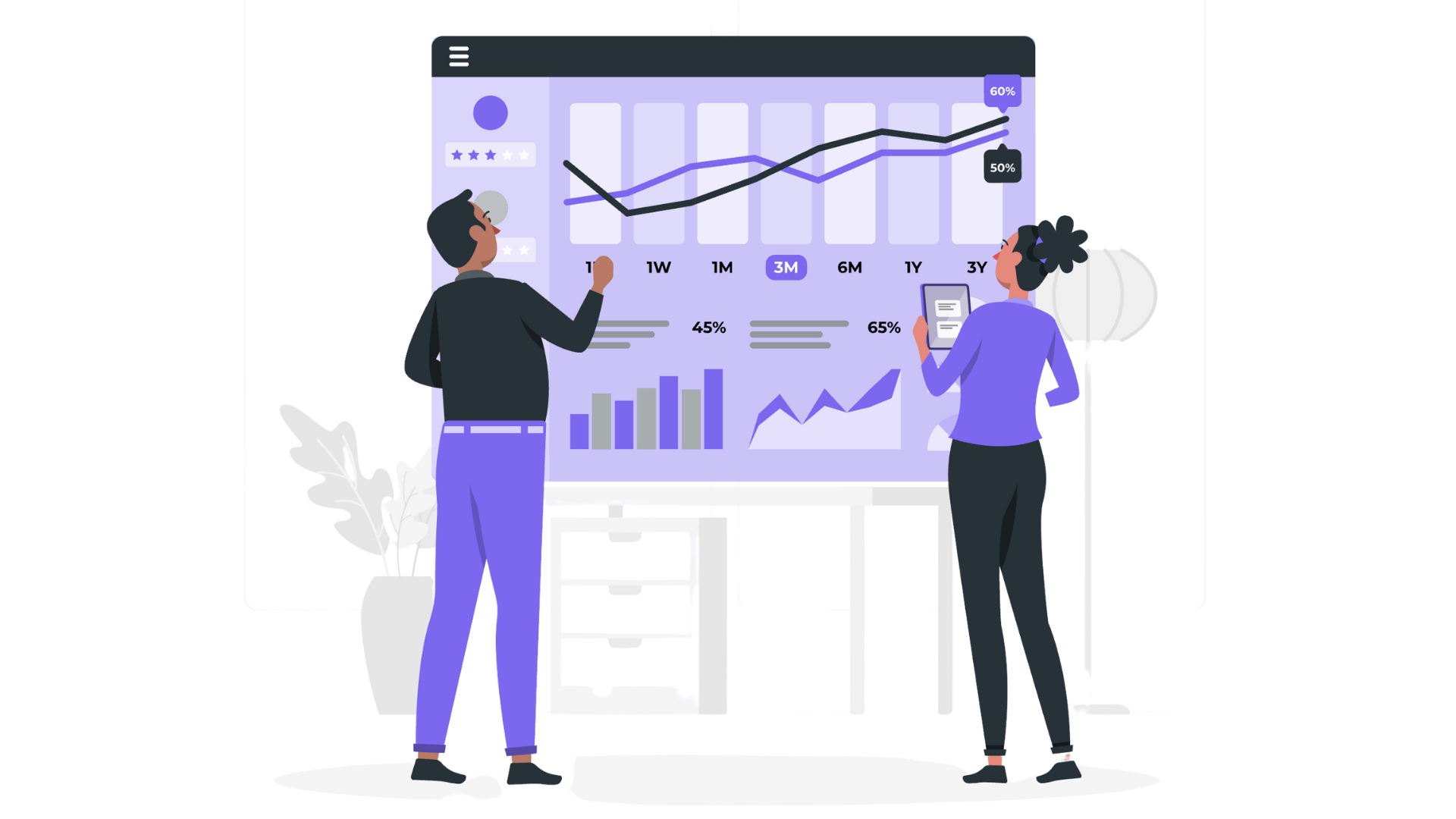
You’ve probably heard the term “sales metrics” more times than you can count. But what exactly does it mean? Simply put, sales metrics are numbers that show how your sales team is doing. They help you understand what’s working, what’s not and where there’s room to improve.
Knowing which metrics to track makes a big difference, whether you’re a founder, a sales manager or just starting out as a sales executive. With the right metrics in place, you can spot problems early, make better decisions and hit your targets faster.
In this blog, we’ll break down the key sales metrics, explain why they matter and show you how to use them to build a better sales process. No fluff. Just clear, useful info you can apply right away.
Sales metrics are measurable numbers that help you track your sales activities. These can cover the full sales process — from the first call to closing the deal and even beyond.
For example:
Each of these gives you clear data on a specific part of your sales process. Some metrics, like call volume, show how active your team is. Others, like revenue per sales rep, reveal how efficient or effective your team really is.
The key point? Sales metrics aren’t just about measuring success. They’re about understanding it so you can double down on what works and fix what doesn’t.
Before you get into what to measure, you need to know why it matters.
Sales is not just about gut feeling or experience — it’s about clarity. If you don’t track your numbers, you’re guessing. And when you’re guessing, you miss patterns, repeat mistakes and waste time on the wrong deals.
Setting clear sales metrics gives you a way to:
Let’s say your team is making hundreds of calls every week. Without metrics, you might assume they’re doing a good job. But what if only 2% of those calls turn into meetings? What if one rep is closing most deals while others are struggling to follow up? These are problems you can’t see without data.
Metrics don’t just help sales managers. They help founders, freelancers, B2B teams, startup hustlers — anyone who’s trying to sell something and grow.
When you track the right metrics, you move from:
“We think this works…” to “We know this works.”
It’s not about tracking everything. It’s about tracking the right things. And that’s exactly what the next section will help you figure out.
When it comes to tracking sales performance, not all metrics do the same job. Some show effort, others reveal results. Some highlight cash flow, others expose hidden inefficiencies.
If you track everything without structure, you end up with a pile of numbers and no real insight. That’s why it’s important to understand the five key categories of sales performance metrics — each built to answer a different question in your sales process.

🛠️ What is your team doing
These metrics track the day-to-day hustle — calls made, emails sent, demos booked, meetings held. They show how active your sales reps are and how much effort is being put into generating and nurturing leads.
Examples:
Why it matters:
If your team isn’t booking enough meetings or sending enough follow-ups, you’ll struggle to fill the pipeline. When results drop, this is the first category you should check.
🔁 How leads move through your sales process
These metrics focus on the journey from lead to close. They tell you how long deals stay in each stage, where leads drop off and how quickly the pipeline moves.

Examples:
Why it matters:
You could be doing all the right activities, but if leads are stuck in the pipeline, you’re not closing. These metrics help you find and fix those roadblocks.
🎯 How well your team is converting leads
This group measures output. Not effort — results. It tells you how many deals you’re closing, how many reps are hitting quota and where your top performers shine.

Examples:
Why it matters:
It separates high activity from high impact. These sales performance metrics show if the hustle is translating into wins.
💰Where the money is coming from
These metrics track actual income — recurring revenue, deal value and revenue per customer. They show you what’s bringing in money and what’s not.

Examples:
Why it matters:
You can’t grow what you don’t measure. These metrics let you forecast, plan and make smart decisions based on hard numbers.
⏱️ How smartly you’re using time and resources
This final category reveals how efficiently your sales engine is running. How long does it take to close, how much does it cost to get a new customer and whether your team is working on the right things.

Examples:
Why it matters:
It’s not just about working harder. It’s about working smarter. These metrics help you scale your sales process without burning out your people or your budget.
Tracking sales metrics isn’t about having fancy dashboards or hitting download on a report every Friday. It’s about using numbers to drive real action.
But here’s the problem: most teams either track the wrong things or track them the wrong way. Let’s break it down.

It’s tempting to track everything because more data = more insights, right?
Not really.
The more you track, the more noise you create. And when you have 30 dashboards to look at, you’ll end up ignoring all of them.
Start small. Track the few metrics that directly impact your sales today.
Pro Tip: Get a sales tracker to efficently track your sales numbers without duplication and errors.

Not all metrics are meaningful.
“Number of calls made” sounds productive, but what if no one answered?
“Email open rate” feels good, but does it lead to revenue?
Vanity metrics make your reports look good but hide deeper problems.
Track metrics that reflect actual progress — like meetings booked, deals won or response time.

The point of tracking sales metrics is to learn something and change what’s not working.
But most teams stop at reporting. They collect the data, paste it into a slide and move on.
That’s a waste.
If your lead response time is too slow, fix the follow-up system. If your win rate drops, review your pitch. Metrics are only useful if they lead to action.

A one-time report doesn’t show trends.
If you only look at your metrics once a month, you miss patterns that could’ve saved deals,
Make metrics part of your weekly sales review, not an end-of-quarter fire drill.

Manual entry, outdated Excel files, CRM data that no one trusts — sound familiar?
The more friction there is in collecting data, the less accurate your metrics will be.
And when reps have to spend 2 hours logging activity just to update a report, they’ll either skip it or fudge the numbers.
Use a tool that automates tracking and gives you clean data without the extra work.
So, now that you know what not to do, how do you decide which sales metrics actually matter?
Because the truth is, not all metrics are for everyone.
A growing startup doesn’t need the same dashboards as a scaled-up sales org. And a solo rep shouldn’t be tracking the same numbers as a 15-person team.
Here’s a simple framework to help you choose smarter — without getting overwhelmed.

Ask yourself:
“What are we trying to improve right now?”
Is it lead generation? Conversions? Faster follow-ups? Bigger deal size?
Let your goals lead the metrics. Don’t just track for the sake of it.
If you’re struggling with low conversions, track your win rate, demo-to-close ratio and objections logged — not how many calls you’re making.
Your sales setup plays a big role in what you should track. Here’s a quick guide:
Team type | Track these first |
Solo rep or early team | Activity metrics + simple funnel (calls, follow-ups, deals closed) |
Growing team (3–10 reps) | Add pipeline movement, win rates, sales rep-level performance |
Mature team (10+ reps) | Layer in revenue, cost, efficiency, regional/product breakdowns |
Don’t copy what big teams do if you’re still getting your basics right.

Focus on metrics that reflect impact, not just effort.
For example:
Every metric you track should tie back to revenue, speed or efficiency.

A good metric should lead to clear action.
If a number changes and no one knows what to do about it, it’s not worth tracking.
For example:
Ask: If this number drops tomorrow, do I know what to change?

Start with 5–10 of the most important sales metrics. Track them consistently for a few weeks.
See how they affect performance. Then, add more if needed.
Simple, well-tracked metrics always beat complex dashboards no one looks at.
You don’t need 100s of metrics to run a smart sales team.
You just need the right ones, which are tracked properly, acted on regularly and aligned with how your team actually works.
Up next: The complete breakdown of the 49 sales metrics worth tracking — across activity, pipeline, performance, revenue and efficiency.With the categories in place, it’s time to look at the specific sales performance metrics that bring structure to your sales process. These are the numbers that help you see what’s working, where things are slowing down and how you can improve performance.
We’ve broken them down by category — with clear definitions, formulas and simple explanations — so you can start tracking what really matters, without overcomplicating it.
The table below breaks down 10 core activity metrics every sales team should track — like follow-up rate, response time and demo-to-close ratio.
# | Metric | Definition | What it shows | Why it matters | How to use it | Formula |
1 | Number of new opportunities created | Total number of potential deals added to the pipeline in a given period | How well your team is generating new business | A drop here could lead to fewer deals later | Track weekly or monthly per rep or source | =COUNT(New Opportunities Created) |
2 | Number of deals in the pipeline | Total open deals currently in the sales funnel | Volume of ongoing sales work | Fewer open deals mean fewer chances of closing | Review by stage and team; compare against targets | =COUNT IF(Deal Status, "Open") |
3 | Number of touches per deal | Average number of contacts (emails, calls or meetings) per deal | How much effort goes into closing a deal | Too few may mean poor follow-up; too many may be inefficient | Set benchmarks and track across reps or industries | =Total Touch points / Number of Deals |
4 | Call-to-meeting conversion rate | Percentage of calls that lead to booked meetings | The impact of your sales calls | Shows how well your team turns outreach into interest | Review scripts and call quality; train for better pitch | =(Meetings Booked / Calls Made) * 100 |
5 | Follow-up rate | Percentage of leads that get at least one follow-up | Your team’s persistence after first contact | Most deals need more than one touch; no follow-up = lost opportunity | Set reminders; use automation to ensure follow-up | =(Leads with Follow-up / Total Leads) * 100 |
6 | Demo-to-close ratio | Percentage of demos that end in a sale | How strong your demos are | A high ratio means a strong product fit or good demo skills | Track conversions from demos; review the qualification process | =(Closed Deals from Demos / Total Demos) * 100 |
7 | Email open rate | Percentage of sales emails that are opened | How effective your subject lines and send times are | If they don’t open the email, they won’t read the message | A/B test subject lines; optimise timing | =(Emails Opened / Emails Sent) * 100 |
8 | Email response rate | Percentage of opened emails that get a reply | How engaging or relevant your message is | Replies move the sale forward | Personalise and keep it short; follow up if no reply | =(Email Replies / Emails Opened) * 100 |
9 | Lead response time | Average time taken to contact a lead after they come in | Speed of follow-up | The quicker the response, the higher the chance of conversion | Aim for minutes, not hours; automate alerts or first reply | =Total Response Time / Number of Leads |
10 | Time spent selling | Percentage of a rep’s work hours spent on direct selling tasks | How efficiently the team uses their time | More selling time usually means more deals closed | Reduce admin; automate non-sales tasks | =(Hours on Sales Activities / Total Working Hours) * 100 |
Monitor how leads progress through your sales process and identify areas for improvement.
# | Metric | Definition | What it shows | Why it matters | How to use it | Formula |
1 | Average sales cycle length | Average number of days from first contact to closing a deal | Speed of your sales process | Longer cycles may indicate inefficiencies or bottlenecks | Identify stages causing delays and streamline processes | =Total Days to Close Deals / Number of Deals |
2 | Win rate | Percentage of deals closed compared to total opportunities | Effectiveness in converting opportunities to sales | Low win rates may suggest issues with qualification or closing strategies | Analyse by product, rep or lead source to identify improvement areas | =(Deals Closed / Total Opportunities) * 100 |
3 | Pipeline coverage ratio | Ratio of total pipeline value to sales target | Sufficiency of the pipeline to meet sales goals | A low ratio may indicate a need for more opportunities | Aim for a ratio of 3:1 or higher to ensure targets are met | =Total Pipeline Value / Sales Target |
4 | Average deal size | Average monetary value of closed deals | Revenue potential per deal | Helps in forecasting and setting realistic targets | Monitor trends to adjust pricing or focus on higher-value opportunities | =Total Revenue / Number of Deals Closed |
5 | Conversion rate by pipeline stage | Percentage of leads moving from one stage to the next | The efficiency of each stage in the sales process | Identifies stages where leads drop off | Focus on improving stages with low conversion rates | =(Leads Advanced to Next Stage / Leads in Current Stage) * 100 |
6 | Sales velocity | Revenue generated per day from the pipeline | The speed at which deals move through the pipeline | Higher velocity indicates a more efficient sales process | Combine with other metrics to assess overall pipeline health | =(Number of Opportunities Average Deal Size Win Rate) / Average Sales Cycle Length |
7 | Deal slippage rate | Percentage of deals that fail to close within the expected timeframe | Reliability of sales forecasts | High slippage may indicate over-optimism or process issues | Adjust forecasting methods and investigate causes of delays | =(Number of Slipped Deals / Total Deals Forecasted to Close) * 100 |
8 | Forecast accuracy | Accuracy of predicted sales compared to actual sales | Reliability of sales predictions | Low accuracy can impact planning and resource allocation | Regularly compare forecasts with actual results to improve prediction methods | =(Actual Sales / Forecasted Sales) * 100 |
9 | Churn rate | Percentage of customers lost over a specific period | Customer retention effectiveness | High churn can negate new sales efforts | Implement retention strategies and monitor customer satisfaction | =(Customers Lost During Period / Total Customers at Start of Period) * 100 |
10 | Net revenue retention (NRR) | Revenue retained from existing customers, including upsells and expansions | Growth within the existing customer base | An NRR of over 100% indicates successful expansion strategies | Focus on customer success and upselling opportunities | =((Revenue at Start + Expansion Revenue - Churned Revenue) / Revenue at Start) * 100 |
Evaluate your team’s ability to convert leads, hit targets and generate revenue.
# | Metric | Definition | What it shows | Why it matters | How to use it | Formula |
1 | Quota attainment rate | Percentage of reps who meet or exceed their sales target | Team’s performance against set goals | Helps you spot top performers and reps who need support | Use to adjust training, targets or team structure | =(Number of Reps Who Hit Quota / Total Reps) * 100 |
2 | Revenue per sales rep | The average revenue generated by each salesperson | Productivity and output of individual team members | Tracks contribution per rep and helps in fair goal setting | Compare across reps to identify outliers | =Total Revenue / Number of Reps |
3 | Sales per region | Total revenue generated from a specific location or geography | Regional sales performance | Helps decide where to invest more or reallocate resources | Analyse regional trends regularly | =SUM(Sales in Region) |
4 | Sales per product or service | Total revenue from each product or service sold | Demand and success of offerings | Reveals what sells best; informs product or pricing decisions | Review regularly and match with the marketing focus | =SUM(Sales of Product or Service) |
5 | Sales by customer segment | Revenue split across different customer types (e.g. SMB, enterprise) | Who your highest-value customers are | Helps tailor outreach and positioning for each segment | Track sales by industry, company size or other filters | =SUM(Sales for Customer Segment) |
6 | Average revenue per user (ARPU) | Average income earned per active customer | Value you’re extracting per account | Helps with pricing, revenue forecasting and expansion decisions | Track monthly, especially in SaaS businesses | =Total Revenue / Total Active Customers |
7 | Upsell rate | Percentage of customers who purchase a higher-tier plan or add-on | Success of account expansion efforts | Indicates how well your team is growing existing accounts | Monitor post-sale interactions and success initiatives | =(Number of Upsells / Total Customers) * 100 |
8 | Cross-sell rate | Percentage of customers who buy related or additional products | Effectiveness of cross-selling | A higher rate means stronger product bundling and customer trust | Train the team on use cases and related offers | =(Number of Cross-sells / Total Customers) * 100 |
9 | Percentage of reps hitting quota | Portion of sales team members meeting or exceeding their goals | Sales team strength overall | Low numbers may reflect unrealistic targets or a lack of support | Compare month over month to track improvement trends | =(Reps Above Quota / Total Reps) * 100 |
10 | Deals closed per rep | Average number of deals each rep closes in a set period | Activity-to-result efficiency | More closed deals usually reflect better qualification and consistency | Helps with goal setting and evaluating sales process efficiency | =Total Closed Deals / Number of Reps |
Track how much money your sales efforts bring in and where it’s coming from.
# | Metric | Definition | What it shows | Why it matters | How to use it | Formula |
|---|---|---|---|---|---|---|
1 | Monthly recurring revenue (MRR) | Predictable monthly income from active subscriptions or retainers | Consistent cash flow from customers | Key metric for SaaS and subscription businesses | Track month-over-month for growth and churn trends | =Sum of Monthly Subscription Values |
2 | Annual recurring revenue (ARR) | Total recurring revenue expected in a full year | Long-term revenue stream | Helps in forecasting and valuation for subscription models | Use for high-level revenue planning and investor reporting | =MRR * 12 |
3 | Average deal size | Average revenue per closed deal | Typical size of your sales | Affects sales strategy, forecasting and pricing | Use to identify upsell potential or discount issues | =Total Revenue / Number of Deals Closed |
4 | Customer lifetime value (CLV) | Total revenue expected from a customer over their entire relationship | Long-term value of each customer | Helps judge how much you should spend to acquire and retain customers | Combine with CAC to assess ROI per customer | =Average Revenue per User × Average Customer Lifespan |
5 | Customer acquisition cost (CAC) | The average cost of acquiring one new customer | Efficiency of marketing and sales spend | The key to understanding profitability | Compare with CLV to ensure you’re not overspending | =Total Sales and Marketing Cost / Number of Customers Acquired |
6 | Revenue per sales rep | Average amount of revenue each rep brings in | Productivity and contribution of individuals | Tracks who’s delivering value and who might need help | Compare across teams or regions | =Total Revenue / Number of Reps |
7 | Revenue by product or service | Revenue broken down by specific offerings | What’s selling and what’s underperforming | Informs marketing, pricing and product strategy | Helps allocate budget and effort accordingly | =Sum of Sales per Product or Service |
8 | Revenue by customer segment | Revenue based on different customer types or sizes | Where the majority of your revenue is coming from | Allows targeted campaigns and custom sales strategies | Group by vertical, deal size or company size | =Sum of Sales per Segment |
9 | Gross revenue retention (GRR) | Percentage of revenue retained from existing customers, excluding upsells | How much existing revenue do you keep | GRR below 90% signals churn issues | Focus on improving support and reducing cancellations | =(Revenue Retained ÷ Starting Revenue) × 100 |
Measure how effectively your sales team utilises time and resources to drive revenue growth
# | Metric | Definition | What it shows | Why it matters | How to use it | Formula |
|---|---|---|---|---|---|---|
1 | Admin time per rep | Average hours a sales rep spends on non-selling tasks | Operational drag on the sales team | Excessive admin time reduces selling opportunities | Identify tasks to automate or delegate | =Total Admin Hours ÷ Number of Reps |
2 | Follow-up lag time | Average delay between initial contact and first follow-up | Responsiveness in nurturing leads | Delays can lead to lost opportunities | Implement reminders and automate follow-ups | =Total Delay (in Days) ÷ Number of Follow-ups |
3 | Revenue per hour worked | Total revenue generated per hour by the sales team | Productivity of sales efforts | Highlights efficiency in revenue generation | Benchmark across teams to identify best practices | =Total Revenue ÷ Total Sales Hours Worked |
4 | Cost per closed deal | Average cost incurred to close a deal | Financial efficiency of closing processes | Helps in budgeting and pricing strategies | Analyse to optimise sales expenditures | =Total Sales Costs ÷ Number of Closed Deals |
5 | Sales efficiency ratio | Revenue generated per dollar spent on sales and marketing | Return on sales and marketing investments | Indicates overall sales profitability | Aim for a ratio >1 for profitable operations | =Revenue ÷ Sales & Marketing Spend |
6 | Cost per ₹1 in pipeline | Amount spent to generate each rupee in the sales pipeline | Demand generation efficiency | Helps in assessing the cost-effectiveness of lead generation | Optimise marketing channels and campaigns | =Total Demand Gen Spend ÷ Total Pipeline Value |
7 | Contribution margin per sale | Revenue from a sale minus its variable costs | Profitability of individual sales | Essential for pricing and product mix decisions | Focus on high-margin products or services | =Sale Price − Variable Costs |
8 | Lead-to-opportunity conversion cost | Average cost to convert a lead into a sales opportunity | Efficiency of the lead qualification process | Identifies cost-intensive stages in lead nurturing | Refine lead scoring and qualification criteria | =Total Lead Nurturing Cost ÷ Number of Opportunities Created |
9 | Proposal-to-close ratio | Percentage of proposals that result in closed deals | Effectiveness of sales proposals | Low ratios may indicate issues in proposal quality or pricing | Review and improve proposal strategies | =(Deals Closed ÷ Proposals Sent) × 100 |
10 | Sales tool utilisation rate | Percentage of sales tools actively used by the team | Adoption of sales enablement tools | Underutilised tools may indicate training needs or redundancies | Conduct regular audits and training sessions | =(Number of Tools Used ÷ Total Tools Available) × 100 |
Once you know which sales performance metrics matter, the next question is: How do you track them?
Because tracking is easy in theory… until you’re juggling spreadsheets, updating data manually and asking your sales reps to “just log everything properly.”
To track metrics well, you need the right tools — ones that save time, reduce friction and actually give you insights you can act on.
Let’s break down your options:
Probably the first thing every team tries.
They’re flexible, easy to start with and work just fine when you’re a one-person sales team.
✅ Pros:
❌ Cons:
Use it if you’re just starting out. But don’t stay here for long.
Most CRMS come with built-in dashboards and reports. You can track deals, contacts and some funnel metrics.
✅ Pros:
❌ Cons:
Use it if you’ve outgrown Excel — but be ready to hit reporting limits quickly.
Tools like Looker, Power BI and Tableau give you total control over reporting but require serious setup, integration and maintenance.
✅ Pros:
❌ Cons:
Use it only if you have a dedicated ops or analytics team.
This is where Telecrm stands out. It’s a sales management software designed to track the exact metrics we’ve discussed — from lead response time and follow-up rate to rep performance, revenue and deal health.
✅ Pros:
❌ Cons:
If you want to stop tracking manually and actually start using your data, give telecrm a shot and see how easy it can be to measure what matters.
Sales metrics aren’t just for writing sales reports. They’re how you understand what’s really happening in your sales process. They show you:
Without them, you’re guessing. And when you guess, you waste time, lose deals and repeat the same mistakes.
This blog wasn’t about giving you 100 things to track. It was about helping you figure out which numbers actually matter, based on your goals, your team and your sales style.
Here’s the bottom line:
You don’t need more data.
You need the right data, tracked clearly, reviewed regularly and used to make real decisions. And for that you can book a demo of Telecrm to experience firsthand how it evaluates your sales numbers and help track just the metrics you need.
Because once you start measuring what matters, you stop reacting and start improving.
One call, one deal, one week at a time.


© Copyright 2025 Telecrm.in - All Rights Reserved • Privacy Policy • T&C


© Copyright 2025 Telecrm.in - All Rights Reserved • Privacy Policy • T&C